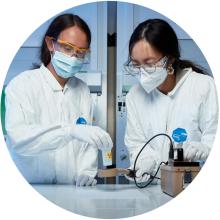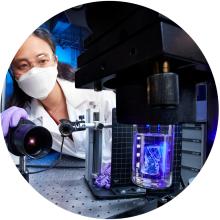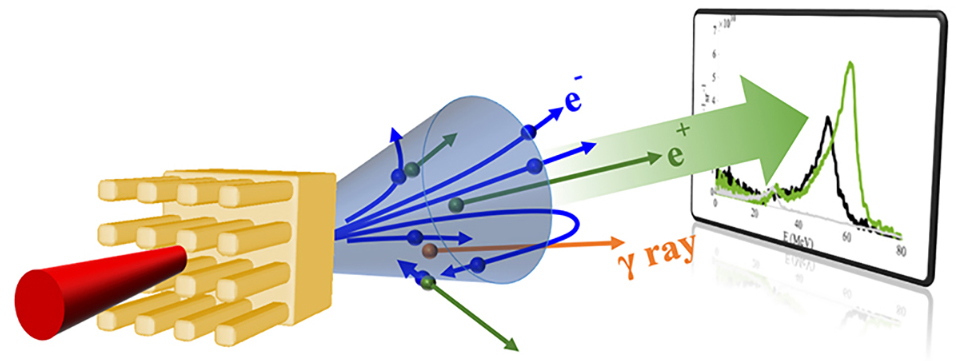Expanding the boundaries of scientific knowledge and advancing the technological state of the art to solve problems of national and global importance
Through its science and technology capabilities, Livermore makes fundamental discoveries about nature, develops innovative technologies that improve life and drive the economy, and carries out its mission to improve national security.
Advances in Machine Learning
Machine learning (ML) is finding wide-ranging applications at LLNL, with many focused on accelerating scientific discovery. For example, Laboratory materials and computer scientists developed an ML model that can quickly and accurately predict 3D crystalline properties of molecules (e.g., density) from their 2D chemical structures. Researchers are using the model to search for new insensitive high-explosive materials. Crystalline density is closely correlated with an energetic’s potential performance. LLNL researchers are also pioneering the application of neural networks to study ion acceleration from targets impacted with a high-intensity short laser pulse. The space of experimental parameters of interest is extremely large. The neural network was trained by an ensemble of more than 1,000 simulations, which only sparsely filled the space. The network acted as a surrogate physics model to explore and discover intriguing features in regions of scientific interest. This approach is widely applicable. LLNL researchers co-authored a paper—in the May 21, 2021, issue of the journal Nature—that discusses future directions and challenges in similarly applying ML to accelerate nuclear fusion research.
In December 2020, two LLNL scientists presented papers at the 34th Conference on Neural Information Processing Systems, the world’s most prestigious ML conference. They addressed issues pertaining to the reliability and robustness of ML algorithms. Laboratory researchers also presented a paper in May 2021 at the International Conference on Learning Representations. They developed a novel framework for a type of discrete optimization called symbolic regression. It outperforms several common benchmarks, including commercial software gold standards. At LLNL, the framework is being used to find short mathematical expressions that fit large data sets gathered from experiments.
Responding to COVID-19
LLNL provided high-performance computing (HPC) resources to the international research community in FY 2021 through the COVID-19 HPC Consortium and the National Virtual Biotechnology Laboratory formed by DOE. Among the Laboratory’s many contributions to the overall HPC effort, a team of biologists and computer scientists developed an ML-training capability that greatly assists the search for therapeutics (e.g., small molecule antivirals). They trained a novel, high-quality molecular design model on 1.6 billion compounds in 23 minutes. The previous state-of-the-art solution required a day for only 1 million compounds. A complementary computational pipeline focused on developing therapeutic antibodies. Promising candidates from both efforts were
screened for antiviral properties using a suite of in-vitro and in-vivo assays.
(round magenta objects)
Experimental activities also supported our nation’s COVID-19 response. LLNL scientists determined that heating N95 respirators up to 75°C for 30 minutes deactivates a surrogate coronavirus without compromising the device’s fit and its ability to filter airborne particles. This type of thermal inactivation offers a widely deployable method for reuse of N95 respirators in emergency situations. Other LLNL research teams leveraged their extensive experience studying the dispersion of airborne hazards to better understand the movement of virus-like particles, supporting efforts to identify countermeasures. A Laboratory-developed tool, DNATrax, allows scientists to study the movement of low concentrations of airborne particles.
Moving to Exascale Computing
With the future delivery of El Capitan (see Nuclear Deterrence), LLNL is fully engaged in the next phase of supercomputing. Exascale machines will be able to process an exaflop—a quintillion (1018) calculations per second. This technological leap offers DOE exciting opportunities to advance its national security, science, and technology-transfer missions; but it also presents enormous challenges. Funded by NNSA and DOE’s Office of Science, DOE’s Exascale Computing Project (ECP) is focused on application development, software technologies, and hardware and integration, with the goal of providing a comprehensive and reliable exascale computing ecosystem. Livermore staff hold key leadership positions in ECP and participate in many projects. ECP coordinates development activities through six co-design centers that draw on multidisplinary expertise from across the DOE laboratories. An LLNL computer scientist leads the co-design Center for Efficient Exascale Discretizations, and LLNL researchers are engaged in two other centers.
An important focus within the Laboratory is the development and usage of sustainable software—ensuring that it is interoperable across computer architectures, maintainable, and dependable. LLNL’s RADIUSS project is deploying and encouraging use across the institution of a common base of foundational scientific software consisting largely of open-source products, many of which have been developed at the Laboratory. This strategy will reduce long-term software costs and increase Livermore’s ability to respond rapidly to emerging programmatic needs. LLNL is a global leader in the development of open-source scientific software solutions that attract collaborators and benefit from their contributions. RADIUSS parallels similar efforts within ECP, in which a Livermore computer scientist heads the project’s Extreme-Scale Scientific Software Development Kit effort.
Planetary Defense Studies
In April 2021, LLNL researchers took part in the seventh International Academy of Astronautics Planetary Defense Conference (PDC). The virtual conference brought together an international group of experts, with Laboratory participants giving presentations on a wide range of topics. The scenario featured at PDC was asteroid disintegration into well-dispersed fragments, which would be necessary if there is little warning and if deflection (the preferred method) is not feasible. Livermore scientists have performed detailed simulations of high-yield nuclear device detonations a few meters from a 100-meter-diameter asteroid two months before expected impact. The fraction of impacting mass would be reduced by a factor of 1,000. Livermore researchers are conducting modeling studies in support of the National Aeronautics and Space Administration’s upcoming planetary defense test, which is targeted at an asteroid called Dimorphos.
A Cosmic Challenge to Quantum Computing
Research by an LLNL physicist and lead collaborators at the University of Wisconsin–Madison shed light on one of the major challenges to realizing the promise and potential of quantum computing—error correction. When errors are caused by an outside energy event, such as absorption of a cosmic ray, the fluctuations in electrical charge of multiple quantum bits (“qubits”) can be highly correlated, as opposed to completely random and independent, and very difficult to correct. The team linked small error-causing perturbations in the qubits’ charge state to the absorption of cosmic rays, a finding that is already impacting how quantum computers are designed.
New Insights into Human Brain Activity
In FY 2021, surgeons at the University of California at San Francisco (UCSF) reported results from groundbreaking studies of human brain activity. LLNL-developed thin-film electrode arrays were used in human patients and generated never-before-seen recordings of brain activity in the hippocampus, a region responsible for memory and other cognitive functions. The arrays recorded electrical signals across the surface of the exposed hippocampus during surgery. While awake, patients were given visual cues and spoke words while their neural activity was recorded. The researchers detected traveling waves and identified new properties about them, including how they may contribute to human cognition. The 32-channel, multielectrode arrays, developed by the Laboratory, enabled their detection. The arrays’ high-density grid layout, small size (smaller than a dime), and their ability to conform to the hippocampal surface provided researchers with a critical bird’s-eye view of how the signals moved over the surface like waves in water.
Since the UCSF study concluded, LLNL engineers have doubled the number of electrodes on the flexible thin-film devices to 64 channels, enabling higher resolution sensing and stimulation. Researchers also formed the arrays into a penetrating (or depth) probe. The goal is to increase the channel count and density to hundreds, or even thousands, of electrodes per device. Combining hybrid polymer materials with microfabrication and 3D printing, engineers have also developed an ultracompact, lightweight and minimally invasive optoelectronic neural implant. Capable of delivering light for neural activation, the devices could be used for high-resolution diagnoses of brain disorders.
Exploring Our Solar System
A team of Livermore scientists and collaborators concluded that our Sun and the solar system formed very quickly—over a time span of less than 200,000 years. The evidence was found in trace quantities of molybdenum (Mo) from calcium-aluminum-rich inclusions (CAIs) that were later incorporated into meteorites. The oldest dated solids in the solar system, CAIs formed near a young Sun over the above-mentioned time span. The team found that distinct isotopic compositions of Mo in CAIs cover the entire range of material formed in the proplanetary disk, indicating the material must have accreted quickly.
In other studies, Laboratory researchers deduced that the current locations of many planetary bodies in our solar system are not where they were formed. The giant planets formed early and as they grew they migrated to gravitationally stable orbits, which reshuffled other planetary bodies that were forming at the time. In addition, high-energy-density science experiments validated the possibity of helium rain inside Jupiter and Saturn. Furthermore, quantum simulations coupled with ML are being used to study the behavior of superionic water expected to be found in ice giants Uranus and Neptune.
Printed "Cellular Fluidics"
Inspired by the way plants absorb and distribute water and nutrients, Livermore researchers developed a groundbreaking method for transporting liquids and gases using a 3D-printed lattice design and capillary action phenomena. The 3D-printed microarchitected structures contain and promote fluid flow to create extensive and controlled contacts between liquids and gases. The ordered, porous, and open-cell structures facilitate surface tension–driven capillary action—akin to a tree pulling water from soil or a paper towel soaking up a spill—and enable liquid and gas transport throughout the structures. The researchers demonstrated absorption of gaseous carbon dioxide (CO2) into a liquid; evaporation of a liquid into a gas phase; and transpiration, where they showed the structures were capable of cooling themselves by evaporating liquid into the atmosphere. The breakthrough technique could have transformative implications for many fields, including electrochemical or biological reactors used to convert CO2 or methane to energy, advanced microfluidics, solar desalination, air filtration, heat transfer, transpiration cooling, and the delivery of fluids in zero-gravity environments.
Advances in Additive Manufacturing
Researchers at LLNL adapted a new class of materials as resins for their groundbreaking volumetric additive-manufacturing (VAM) techniques that produce objects almost instantly. Photosensitive syrup-like resin rotates in a container as it is illuminated by projected laser light. After a few-minute exposure, the fluid is drained, leaving a cured, fully formed 3D object. The newly adapted materials for VAM are called thiol-ene resins. Previously, researchers worked with acrylate-based resins that produced brittle and easily breakable objects. The new resin chemistry, created by carefully balancing three different types of molecules, provides a wider range of mechanical performance. Researchers are able to build tough and strong, as well as stretchable and flexible, objects with VAM and thiol-ene resins. Using molecular dynamics simulations, LLNL scientists continue to push the boundaries of 3D printing to discover new custom photosensitive resins.
Exploratory research projects at the Laboratory supported innovative 3D-printing applications. Livermore researchers developed a technique to print transparent ceramics with extremely fine feature sizes (tens of micrometers) for use as laser-amplification media. They also used multimaterial 3D printing to create tailored gradient refractive index glass optics that could make better specialized military eyewear and virtual reality goggles. Other Livermore scientists developed a new method for 3D printing living microbes in controlled patterns, expanding the potential for using engineered bacteria to recover rare-earth metals, clean wastewater, and detect uranium. In addition, a Laboratory team 3D printed the first-ever living aneurysm, which can be used to improve surgical procedures and personalize treatments.
Doubling Antimatter Production
Laboratory scientists achieved a near 100 percent increase in the amount of antimatter created in an experiment using the same laser energy. The team shot a high-intensity laser through a gold target that included specially designed microstructures on the front surface, which increased antimatter production from about 100 billion particles of antimatter to twice that number. The advance, which has many applications, is a key step toward the goal of making enough electron–positron pairs to study the physics of gamma-ray bursts.












